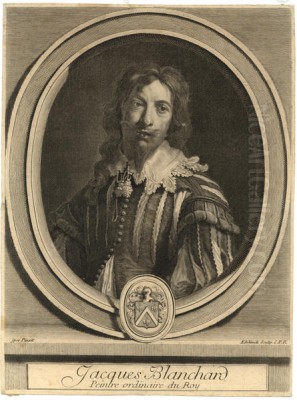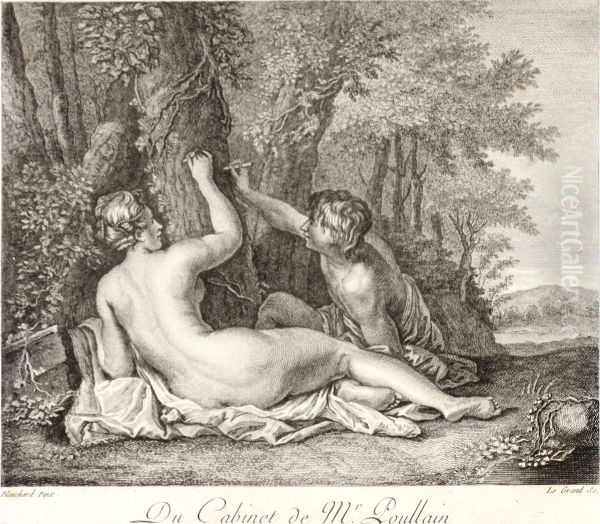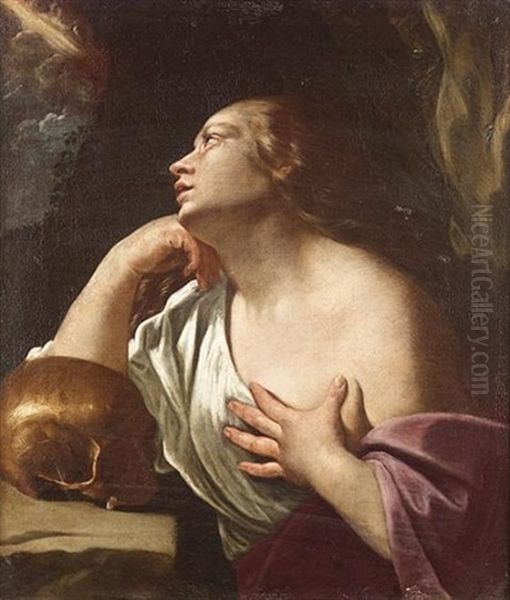
Jacques Blanchard (1600-1638) stands as a significant, albeit tragically short-lived, figure in the landscape of 17th-century French Baroque art. Often dubbed "the French Titian" for his rich, sensuous color palette and painterly technique, Blanchard carved a unique niche for himself, distinct from many of his contemporaries. His work, characterized by its delicate handling of light, tender emotionality, and a preference for mythological and intimate religious scenes, offers a fascinating glimpse into the artistic currents of Paris before the full ascendancy of the academic classicism championed by figures like Charles Le Brun under Louis XIV.
Early Life and Artistic Formation
Born in Paris in 1600, Jacques Blanchard's initial artistic training was rooted in a familial environment. His first teacher was his maternal uncle, Nicolas Bollery (also spelled Baullery, c. 1560-1630), a painter of modest renown. This early exposure likely provided Blanchard with a foundational understanding of painting techniques prevalent in Paris at the turn of the century, which still bore traces of late Mannerism.
Seeking to broaden his horizons, Blanchard later moved to Lyon, a vibrant artistic center in its own right. There, he entered the workshop of Horace Le Blanc (or Le Blanc, 1575-1637) around 1620. Le Blanc himself had spent time in Italy, and his workshop would have exposed Blanchard to more contemporary artistic ideas, possibly including early echoes of the burgeoning Baroque style and the lingering influence of the School of Fontainebleau. This period in Lyon, though not extensively documented, was crucial in preparing him for the next, most formative stage of his artistic development: his journey to Italy.
The Italian Sojourn: A Venetian Revelation
In 1624, at the age of twenty-four, Jacques Blanchard embarked on the quintessential artistic pilgrimage to Italy, a journey that would profoundly shape his style and artistic vision. He initially spent time in Rome, the epicenter of the Baroque movement, where he would have encountered the dramatic tenebrism of Caravaggio and his followers, as well as the classicizing currents of Annibale Carracci and Domenichino. The works of artists like Guido Reni and Guercino, with their blend of classical grace and Baroque dynamism, were also prominent.

However, it was his subsequent stay in Venice, from approximately 1626 to 1628, that proved most decisive. The Venetian tradition, with its emphasis on colorito (color and brushwork) over disegno (drawing and design), resonated deeply with Blanchard. He immersed himself in the works of the great Venetian masters of the 16th century: Titian (Tiziano Vecellio), Paolo Veronese, and Jacopo Tintoretto. Titian's rich, warm colors, sensuous depiction of flesh, and mastery of atmospheric effects left an indelible mark. Veronese's opulent compositions and silvery light, and Tintoretto's dramatic lighting and dynamic figures, also contributed to Blanchard's evolving aesthetic. It was in Venice that he truly found his artistic voice, absorbing the lessons of these masters and beginning to forge his own distinctive style, particularly evident in his mythological compositions from this period.
Return to Paris: The "French Titian"
Blanchard returned to Paris in 1628 or 1629, his artistic sensibilities thoroughly imbued with the Venetian spirit. He quickly established himself as a prominent painter, offering a compelling alternative to the more austere or dramatically Caravaggesque styles then current. His arrival coincided with a period of artistic ferment in Paris. Simon Vouet, another French artist who had spent considerable time in Italy, had returned in 1627 and was already a dominant force, introducing a grand, decorative Italian Baroque style.
Despite Vouet's prominence, Blanchard's unique qualities found favor. His art was characterized by a softer, more lyrical touch, a delicate and often pearly luminosity, and a refined sensuality. His colors were rich yet harmonious, his brushwork fluid and expressive. These qualities, so reminiscent of the Venetian master, earned him the laudatory nickname "le Titien français" (the French Titian) from contemporaries like André Félibien, a key art historian of the period. This appellation underscored his mastery of color and his ability to imbue his subjects with a vibrant, lifelike warmth.
Artistic Style and Thematic Concerns
Blanchard's oeuvre primarily comprises religious paintings and mythological subjects, often on a relatively small scale, suitable for private devotion or the collections of discerning connoisseurs. His style is a harmonious blend of Venetian colorism and a French sensibility for grace and elegance.
In his religious works, Blanchard often depicted tender scenes from the life of the Holy Family or saints in moments of quiet contemplation or ecstasy. He avoided the high drama and overt theatricality favored by some Baroque artists, opting instead for a more intimate and human portrayal of sacred figures. His Madonnas are often characterized by their gentle beauty and maternal warmth, their forms softly modeled and bathed in a subtle, diffused light.

His mythological paintings allowed him to explore the sensuous beauty of the human form, a subject he approached with a characteristic delicacy. Nudes are rendered with a soft, pearly quality, their flesh tones subtly modulated. These works, while often erotic in theme, generally avoid overt vulgarity, maintaining an air of refined elegance. He drew upon classical mythology for narratives of love, beauty, and pastoral idylls, themes popular with the sophisticated Parisian clientele of the era.
A key element of Blanchard's style is his sophisticated use of chiaroscuro, though his approach differed from the stark tenebrism of Caravaggio. Blanchard's light is softer, more atmospheric, creating gentle transitions between light and shadow that enhance the three-dimensionality of his figures and contribute to the overall mood of his compositions. His palette is rich and varied, often featuring warm reds, blues, and golden yellows, applied with a visible, yet controlled, brushstroke that adds texture and vibrancy to his surfaces.
Representative Works
Though his career was brief, Jacques Blanchard produced a number of memorable works that exemplify his style and artistic preoccupations.
Danaë (c. 1620s, Blanton Museum of Art, Austin): Likely painted during or shortly after his Italian sojourn, this work showcases his absorption of Venetian influences. The reclining figure of Danaë, awaiting the golden shower of Jupiter, is rendered with a sensuousness and a rich play of light and color that clearly evokes Titian. The soft modeling of her form and the luxurious textures of the drapery are characteristic.
Mars and the Vestal Virgin (also known as Mars and Rhea Silvia, 1637-1638, Art Gallery of New South Wales, Sydney): This late work depicts the mythological encounter that led to the birth of Romulus and Remus. The composition is dynamic, with Mars descending towards the sleeping Vestal. Blanchard's skill in rendering flesh tones and his rich color palette are evident, as is his ability to convey a sense of drama and sensuality within an elegant framework.
Angelica and Medoro (c. 1630s, The Metropolitan Museum of Art, New York): This painting illustrates a scene from Ariosto's epic poem Orlando Furioso. The tender moment between the two lovers is captured with Blanchard's characteristic sensitivity. The figures are gracefully posed, and the landscape setting contributes to the idyllic mood. The soft light and harmonious colors enhance the romantic theme.
![L'annonciation [jacques Blanchard ; The Annunciation ; Oil On Panel] by Jacques Blanchard](https://www.niceartgallery.com/imgs/1185035/m/jacques-blanchard-lannonciation-jacques-blanchard-the-annunciation-oil-on-panel-e40fc3e5.jpg)
The Birth of the Virgin (location varies, several versions/studies exist): This subject, and others related to the Holy Family, were frequently treated by Blanchard. These works often emphasize the humanity and tenderness of the sacred figures. For instance, a version in the Notre-Dame Cathedral in Paris (though its status post-fire needs verification) was celebrated for its gentle piety.
The Holy Family and St. Agnes Adoring the Infant Jesus: These are examples of his religious paintings, often characterized by their intimate scale and devotional warmth. Works like these were commissioned for private chapels and collections, reflecting a growing demand for more personal religious art. Some of these were also destined for Parisian churches, such as Notre-Dame.
St. Andrew Kneeling Before the Cross: This work demonstrates Blanchard's ability to convey deep religious feeling. The saint's devotion is expressed through his pose and facial expression, rendered with a combination of realism and idealized grace.
Blanchard also undertook decorative projects for private residences and Parisian hôtels particuliers (grand townhouses). For example, he contributed to the decoration of the Hôtel Le Barbier, creating mythological scenes that further cemented his reputation. Unfortunately, many of these large-scale decorative works have not survived, leaving us with a somewhat incomplete picture of this aspect of his career.
Blanchard and His Contemporaries
The Parisian art world of the 1630s was a dynamic and competitive environment. Simon Vouet (1590-1649) was arguably the most dominant figure, having returned from Italy in 1627 with a grand, decorative Baroque style that appealed to the court and aristocracy. Vouet's workshop was prolific, and he received numerous prestigious commissions. Blanchard and Vouet were often seen as rivals, though their styles differed significantly. While Vouet's art was characterized by its robust figures, dramatic compositions, and often cooler palette, Blanchard offered a softer, more coloristically rich, and intimate alternative. This "rivalry" was likely more a matter of stylistic differentiation and competition for patronage than personal animosity.
Other notable French painters active during Blanchard's career included:
Nicolas Poussin (1594-1665): Though Poussin spent most of his career in Rome, his classicizing, intellectual style had a profound impact on French art, offering a more austere and rigorously composed alternative to the Baroque.
Claude Lorrain (1600-1682): Also based in Rome, Claude was the master of the idealized classical landscape, his works admired for their poetic light and serene beauty.

Philippe de Champaigne (1602-1674): A Flemish-born painter active in Paris, Champaigne was known for his sober, realistic portraits and his deeply spiritual religious paintings, often associated with Jansenism.
Laurent de La Hyre (1606-1656): La Hyre's style evolved, but he is often associated with a refined, elegant classicism, sometimes termed "Parisian Atticism," characterized by clear compositions and cool colors.
Georges de La Tour (1593-1652): Working in Lorraine, La Tour developed a highly individual style, influenced by Caravaggio, known for its dramatic nocturnal scenes illuminated by candlelight and its profound spiritual intensity.
The Le Nain Brothers (Antoine, Louis, and Mathieu): These artists were known for their dignified and empathetic depictions of peasant life, as well as religious scenes and portraits.
Sébastien Bourdon (1616-1671): A younger contemporary, Bourdon was a versatile artist who worked in various styles, including Bamboccianti-esque genre scenes, Poussin-inspired classical compositions, and portraits.
Jacques Stella (1596-1657): A friend of Poussin, Stella also worked in a classicizing vein, producing elegant religious and mythological paintings.
Blanchard's art, with its Venetian warmth, stood somewhat apart from the more dominant classicizing or robust Baroque trends. He shared with Vouet an Italianate foundation, but his interpretation was more personal and less geared towards grand public statements. His focus on color and light provided a distinct voice in the Parisian art scene.
Patronage and Recognition
Blanchard's refined and sensuous style appealed to a sophisticated clientele of private collectors and connoisseurs in Paris. He received commissions for altarpieces for churches, such as Notre-Dame, and for decorative schemes in private residences. His smaller easel paintings, particularly his mythological and allegorical subjects, were sought after for private collections.
His talent did not go unnoticed by the Crown. He was appointed Peintre ordinaire du Roi (Ordinary Painter to the King), a prestigious title that acknowledged his standing in the artistic community. This royal recognition, alongside his popularity with private patrons, indicates the success he achieved during his relatively short career.
Premature Death and Legacy
Tragically, Jacques Blanchard's promising career was cut short by his premature death in Paris in 1638, at the age of just thirty-eight. The exact cause of his death is not well-documented, often attributed to a sudden illness, possibly pneumonia or consumption. His early demise deprived French art of a unique talent just as he was reaching full maturity.

Despite the brevity of his working life (essentially a decade in Paris), Blanchard left a discernible mark. His emphasis on color, light, and a softer, more lyrical emotionality provided an important counterpoint to the more heroic or severely classical styles. He demonstrated that French art could embrace the richness of Venetian colorism without sacrificing French elegance and grace.
His influence can be seen in the work of some subsequent artists who valued painterly qualities and a more sensuous approach. While the grand classicism of Poussin and later Le Brun would come to dominate French academic art, Blanchard's legacy persisted, particularly in the realm of more intimate and decorative painting. Artists like Eustache Le Sueur (1616-1655), in his earlier, more lyrical phase, show some affinities with Blanchard's delicate touch and harmonious color.
In the broader history of French art, Jacques Blanchard represents an important moment of Venetian influence, a "painter's painter" admired for his technical skill and his beautiful handling of his medium. His works continue to be appreciated for their refined sensuality, their luminous color, and their gentle, poetic charm.
Surviving Works and Collections
Jacques Blanchard's paintings are held in a number of prestigious museums and collections around the world. Key institutions include:
The Louvre Museum, Paris: Holds several important works, reflecting his significance in French art history.
The Metropolitan Museum of Art, New York: Features his Angelica and Medoro.
The Blanton Museum of Art, University of Texas at Austin: Home to the notable Danaë.
Art Gallery of New South Wales, Sydney: Houses Mars and the Vestal Virgin.
Various French regional museums, such as those in Lyon, Rennes, and Cherbourg, also have examples of his work.
Works historically attributed to him were in Notre-Dame Cathedral in Paris, though their current condition and accessibility may be affected by the 2019 fire.
The dispersal of his works and the loss of some of his decorative cycles mean that a full appreciation of his oeuvre requires study across these collections. However, what survives is sufficient to confirm his status as a gifted colorist and a sensitive interpreter of both sacred and profane themes.
Conclusion: A Luminous but Brief Flame
Jacques Blanchard's career, though tragically curtailed, was a luminous one. As "the French Titian," he brought a distinctively Venetian warmth and sensuality to Parisian art in the 1630s. His delicate handling of light, his rich yet subtle color harmonies, and his ability to convey tender emotion set him apart. He navigated a complex artistic landscape, finding his own voice amidst the grandeur of Vouet and the burgeoning classicism that would soon define French art for generations.
While he may not have achieved the overarching influence of a Poussin or a Le Brun, Jacques Blanchard remains a captivating figure. His art offers a moment of lyrical beauty, a testament to the enduring appeal of color and light, and a reminder of the rich diversity of French Baroque painting. His legacy is that of a master colorist, a painter of refined sensibility whose works continue to enchant viewers with their poetic grace and quiet radiance.